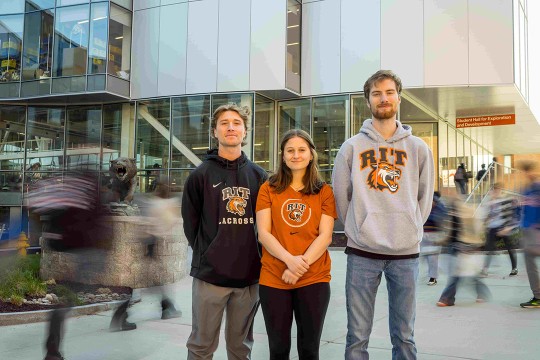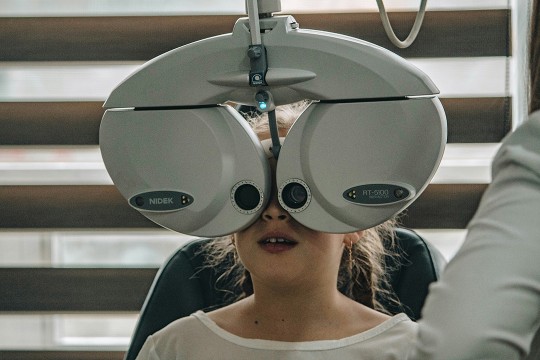RIT leads regional response to ventilator shortage, creating prototype to aid coronavirus fight
Collaborative project involves leading designers, local companies and healthcare experts
The prototype ventilator plugs into the oxygen source available in most hospital rooms or into a tank of oxygen. Laboratory testing so far has shown performance successfully meeting clinicians’ requirements for COVID-19 patients.
Rochester Institute of Technology is leading an effort involving local companies and healthcare experts to produce a prototype ventilator designed to help meet the continuing surge of respiratory cases as a result of the coronavirus.
According to Nabil Nasr, associate provost and founding director of the Golisano Institute for Sustainability (GIS), the collaborative project between RIT researchers—working in tandem with regional experts and healthcare providers—resulted in the creation of an emergency prototype ventilator that will help doctors and nurses on the front lines in the medical treatment of patients fighting COVID-19.
The prototype ventilator plugs into the oxygen source available in most hospital rooms or into a tank of oxygen. Laboratory testing so far has shown performance successfully meeting clinicians’ requirements for COVID-19 patients.
“This has been a collaborative effort between the project team and the clinicians working together with only one focus: meeting the needs of our community and beyond,” Nasr said.
He credited U.S. Congressman Joseph Morelle with getting the project started three weeks ago when Morelle called him immediately after receiving a briefing about the critical ventilator shortage from New York Gov. Andrew Cuomo.
“Rochester has always been a leader in innovative technology—and now, we are using our unique expertise to help fill a critical need for ventilators during the global COVID-19 pandemic,” Congressman Morelle said. “In times of crisis, we must come together to help our fellow Americans. I am profoundly grateful to RIT for their collaboration and commitment to this project, which will have life-saving implications for our community and our country.”
Nasr moved quickly to assemble a team comprising nearly two dozen research engineers and staff at GIS as well as senior engineers from the Center for Integrated Manufacturing Studies (CIMS) and the New York State Pollution Prevention Institute (NYSP2I), along with several RIT co-op students.
Led by Michael Thurston, director of the New York State Center of Excellence in Advanced and Sustainable Manufacturing at RIT as well as technical director and research faculty at GIS, team members have worked virtually around the clock with project partners since mid-March to develop the prototype ventilator for production, pending final U.S. Food and Drug Administration (FDA) approval.
“Our partners promised all of their resources and made their facilities available to help us,” said Nasr, who has worked in the fields of sustainable manufacturing, remanufacturing and sustainable product development for more than 30 years and is considered an international leader in those disciplines.
The team identified a proven, simpler portable ventilator, continued to source materials, and modified it to fit COVID-19 cases before designing a prototype unit and a manufacturing plan. It then was tested and demonstrated for doctors from Rochester Regional Health on March 30.
After making a number of modifications to the prototype based on feedback from doctors, RIT is working with collaborators from the University of Rochester assisting with final FDA approvals and providing feedback on certain ventilator functions.
Nasr cited additional collaborators for their significant efforts, including RIT Trustee and Vice Chair David J. Burns, principal and founder of Global Business Advisory Services LLC; G.W. Lisk; Mark Schiesser, principal of Adaptive Automation; and Appcon Group, Inc.
“The modification of the device needed significant testing and consultation with the clinicians,” he said. “We are at the final phase of testing and units are being produced in small numbers for validation. We expect that we will be ready for a higher number within a few weeks.”
Nasr added the research team has opted for an injection molding process—made possible by consultation with Century Mold, Tessy Plastics Corp., Harbec Plastics and Currier Plastics—in the manufacturing of the units and he estimated that the tooling would “last up to a million cycles.”
“So once we can get the production moving with our manufacturing partners, we could meet the needs of medical facilities in the U.S. and beyond,” he said.
Realizing that time is critical to get the prototypes produced as soon as possible, Nasr noted, the team working on the prototype ventilator transferred all design knowledge and documentation as well as prototyped parts to a large manufacturer to use its supply chain to produce the prototype ventilator in high volume. The team is continuing to support the manufacturer to ensure a fast production cycle.
He’s hopeful that RIT’s tireless work over the past month will go a long way in the ongoing fight against the coronavirus pandemic.
“The hospitals are the ones on the front lines of this medical battle,” Nasr said. “It has been an emotional rollercoaster to hear their stories and see what the doctors, nurses and patients are going through. It’s been extremely tough. It’s such a crisis.”















